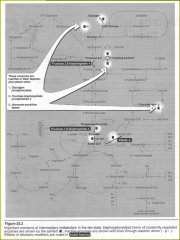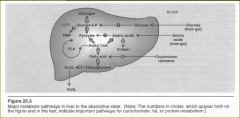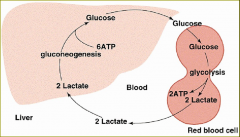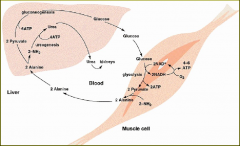![]()
![]()
![]()
Use LEFT and RIGHT arrow keys to navigate between flashcards;
Use UP and DOWN arrow keys to flip the card;
H to show hint;
A reads text to speech;
15 Cards in this Set
- Front
- Back
- 3rd side (hint)
|
absorptive state is 2-4 hours after a meal.
increases in plasma glucose, triacylglycerol and amino acids β-cells in pancreas respond to glucose and amino acids by increasing secretion of ____ and decreasing secretion of ________ |
insulin
glucagon |
|
|
|
Four mechanisms control metabolic flux:
|
1. Availability of substrates (Amount of time = )
2. Allosteric activation and inhibition of enzymes (Amount of time =) 3. Covalent modification of enzymes (minutes to hours) phosphorylation kinases (either serine threonine, tyrosine) and dephosphorylation by phosphatases. 4. induction or repression of enzyme synthesis (Amount of time =) can be transcriptional or post-transcriptional regulation |
minutes
minutes minutes to hours hours to days |
|
|
allosteric =
involve rate-determining reactions |
(biochemistry, of an enzyme)
binds a compound on an inactive site and thus changes conformation in order to become either active or inactiv |
|
|

In the fed state, most of the enzymes are in the dephosphorylated form and are =.
|
active
3 enzymes are an exception: They are inactive after dephosphorylatiton: |
- Glycogen phosphorylase
- Fructose bisphosphate phosphatase-2 - Hormone sensitive lipase |
|
|
Induction or repression of enzyme synthesis
Insulin -------> glucokinase mRNA -------> |
glucokinase
|
|
|
|
Induction or repression of enzyme synthesis
Insulin -------> G6PD mRNA -------> G6PD -------> |
6-phosphogluconate
|
|
|
|
Induction or repression of enzyme synthesis
Insulin PEP carboxykinase mRNA ------> |
PEP carboxykinase
|
|
|
|
liver is uniquely situated to process and distribute nutrients
liver takes up = 3ct |
glucose,
lipid most amino acids nutrients are metabolized stored or rerouted to other tissues liver buffers large variations in nutrient availability to the peripheral tissues |
|
|
|
liver is usually a glucose-producing organ
in absorptive state, liver is a net consumer of _______ retains __of every 100g of glucose in portal vein |
glucose
60 |
|
|
|
Hepatic metabolism is increased by these mechanisms:
|
1. increased _______ of glucose
- Glucokinase activity increases phosphorylation of glucose to = - in the post-absorptive state glucokinase is inactive due to high__ = 2. increased glycogen synthesis - inactivation of glycogen phosphorylase - activation of glycogen synthase 3. increased hexose monophosphate pathway activity - stimulated by increased glucose-6-P and decreased NADPH due to lipogenesis - accounts for 5 to 10% of liver glucose utilization |
phosphorylation
glucose-6-P Km |
|
|
Hepatic metabolism is increased by these mechanisms:
- ____ activity increases phosphorylation of glucose to glucose-6-P - in the post-absorptive state glucokinase is _____ due to high Km |
Glucokinase
inactive - increased insulin to glucagon ratio stimulates enzymes in glycolytic pathway like___ ___ & ___. |
phospho-fructokinase
and pyruvate kinase - the product, acetyl CoA, is used as a building block for fatty acids or provides energy by oxidation in the TCA cycle |
|
|
Hepatic metabolism (cont’d)
decreased gluconeogenesis as glycolysis goes up, _____ goes down |
gluconeogenesis
_____ _____ activity is low since acetyl CoA levels are low, an essential allosteric activator of this enzyme |
pyruvate carboxylase
high insulin:glucagon ratio inactivates some gluconeogenic enzymes and decreases synthesis of PEPCK (rate-controlling enzyme of gluconeogenesis) |
|

Absorbtive Metabolic State Pathway
|

Cori Cycle
|

Glucose-Alanine Cycle
|
|
|
Fat metabolism
increased fatty acid synthesis primary site for de novo synthesis of fatty acids favored by availability of substrates, acetyl CoA from glycolysis and NADPH from HMP pathway .... |
also favored by activation of___________________ , converting acetyl CoA to malonyl CoA (rate-limiting)
|
acetyl CoA carboxylase
i increased triacylglycerol synthesis favored by availability of fatty acyl CoA from de novo synthesis and from chylomicrons and VLDLs glycerol-3-P is available from glycolysis triacylglycerols packaged in VLDLs are secreted by the liver for use by extrahepatic tissues (fat and muscle) |
|
|
Amino acid metabolism
increased amino acid degradation surplus amino acids sent to blood or deaminated and the carbon skeletons are either catabolized to pyruvate, acetyl CoA or TCA cycle intermediates or used for energy or fatty acid synthesis ___ ____ amino acids are degraded in muscle |
branched-chain
increased protein synthesis no storage for amino acids like glucose or fatty acids increase in protein synthesis if needed for replacement from breakdown from previous post-absorptive state |
|

